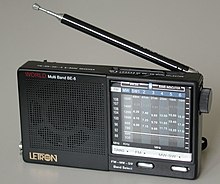World receiver
A world receiver is a radio device that is particularly suitable for receiving shortwave radio transmitters . The name arises from the fact that shortwaves spread over the entire globe from a single transmitter and can thus be received worldwide. Often these radios can also receive additional frequency bands and VHF radio.
Portable world receivers were introduced in 1939 by Eugene F. McDonald , head of Zenith Radio Corporation .
particularities
The designs of world receivers range from small pocket receivers, hardly larger than a pack of cigarettes, and portable receivers in various sizes to large, powerful station receivers.
In addition to the capabilities of a normal radio device, world receivers are specially designed for receiving remote stations. To do this, they need a high input sensitivity, but also a high degree of selectivity to mask out neighboring stations and other interference.
A more powerful additional antenna can often be connected to pocket-sized receivers.
Special techniques such as a switchable synchronous detector for processing the weakest signals, an adjustable input sensitivity or a preselection (tuning of the antenna preamplifier) also facilitate the reception of weak or badly disturbed broadcasts considerably.
In high-quality versions, world receivers usually work as two-stage superimposing receivers ( double conversion ), some particularly complex devices also work as triple conversion with three intermediate frequencies or mixing stages. Professional receivers with four levels were also rarely found.
Many of the simpler analog pocket receiver or older portable receiver, however, are mostly kept as single conversion with only one intermediate frequency or mixing stage, which is why they compared to the double Supern receiving significantly less strong as well as little resistant to image frequency are interferences.
service
Many high-quality world receivers display the received frequency on a digital display , usually coupled with the option of entering the frequency directly using the numeric keys.
In the case of analogue tunable world receivers (i.e. using a pointer on a scale), the frequency bands are spread, in contrast to conventional radio devices , that is, divided into several sub-ranges, each of which encompasses the entire length of the scale, in order to be able to tune very precisely to closely spaced transmitters. Often there is also an additional frequency fine-tuning.
Special reception options
For medium to well-equipped world receivers also special to modulation types such as single-sideband (SSB, English single sideband ) with a choice of the upper (USB, English upper sideband ) or lower (LSB, English lower sideband ) sideband be used. As a result, in addition to shortwave broadcasting, you can also receive the amateur radio service on shortwave. However, since world receivers are primarily designed to receive (long-distance) radio (especially shortwave), other modes of operation, such as radio telex , cannot be received with a world receiver or can only be received with additional devices.
Some newer world receivers offer the possibility of receiving digital shortwave signals such as those broadcast by some radio stations of the Digital Radio Mondiale consortium (DRM).
Meaning of the world receiver
The operation of a shortwave radio transmission system is usually associated with a lot of effort. Since with the end of the Cold War, both the motivation to broadcast for propaganda reasons and the need to provide “neutral” information no longer existed, broadcasting goes back to shortwave worldwide. There have been no state shortwave radio stations in operation in Germany, Austria or Switzerland since 2016. Internet radio or podcasts are often referred to as possible substitutes .
Operating an Internet radio or broadcasting a radio broadcast over the Internet is incomparably easier than operating a shortwave transmitter. There are no frequency shortages or problems with wave propagation. The ranges that can be achieved via the Internet are large - but precisely those areas are not reached that are technically undersupplied or in which divergent views are suppressed by the state for political reasons and in which the Internet is consequently also censored (e.g. China , Iran , North Korea ). In these areas, shortwave broadcasting is still one of the few direct sources of information.
See also
literature
- Gerd Klawitter: Kaufberater Weltempfänger What can ... What should ... What must he be able to , Verlag für Technik und Handwerk neue Medien GmbH, Baden-Baden 2012, ISBN 978-3-88180-873-6



